

Impress Guide
Chapter
10
Printing, E-mailing, Exporting, and
Saving Slide Shows
This document is Copyright © 2005–2011 by its contributors as listed below. You may distribute it and/or modify it under the terms of either the GNU General Public License (http://www.gnu.org/licenses/gpl.html), version 3 or later, or the Creative Commons Attribution License (http://creativecommons.org/licenses/by/3.0/), version 3.0 or later.
All trademarks within this guide belong to their legitimate owners.
Contributors
Michele
Zarri
T. Elliot Turner
Jean Hollis Weber
Feedback
Please direct any comments or suggestions about this document to: documentation@global.libreoffice.org
Acknowledgments
This chapter is based on Chapter 10 of the OpenOffice.org 3.3 Impress Guide. The contributors to that chapter are:
Nicole
Cairns
Peter Hillier-Brook
Jean Hollis Weber
Michele Zarri
Publication date and software version
Published 31 July 2011. Based on LibreOffice 3.3.3.
Some keystrokes and menu items are different on a Mac from those used in Windows and Linux. The table below gives some common substitutions for the instructions in this chapter. For a more detailed list, see the application Help.
|
Windows/Linux |
Mac equivalent |
Effect |
|
Tools > Options menu selection |
LibreOffice > Preferences |
Access setup options |
|
Right-click |
Control+click |
Open context menu |
|
Ctrl (Control) |
z (Command) |
Used with other keys |
|
F5 |
Shift+z+F5 |
Open the Navigator |
|
F11 |
z+T |
Open Styles and Formatting window |
Contents
Selecting general printing options 5
Printing multiple pages on a single sheet of paper 5
Selecting other information to print 7
Printing in black and white (on a color printer) 7
Printing handouts, notes, or outlines in Impress 7
Selecting default print options 8
Controlling PDF content and quality 9
General page of PDF Options dialog box 9
Initial View page of PDF Options dialog box 11
User Interface page of PDF Options dialog box 12
Links page of PDF Options dialog box 13
Security page of PDF Options dialog box 13
Exporting as web pages (HTML files) 15
Digital signing of documents 19
Opening and saving a PowerPoint file 20
This chapter provides information about printing, exporting, and e-mailing documents from LibreOffice Impress.
Click
the Print
File Directly icon
![]() to send the entire document to the default printer defined for your
computer.
to send the entire document to the default printer defined for your
computer.
|
Note |
You can change the action of the Print File Directly icon to send the document to the printer defined for the document instead of the default printer for the computer. Go to Tools > Options > Load/Save > General and select the Load printer settings with the document option. |
Impress provides many options for printing a presentation: with multiple slides on one page, with a single slide per page, with notes, as an outline, with date and time, with page name, and more.
For more control over printing a presentation, choose File > Print to display the Print dialog box.
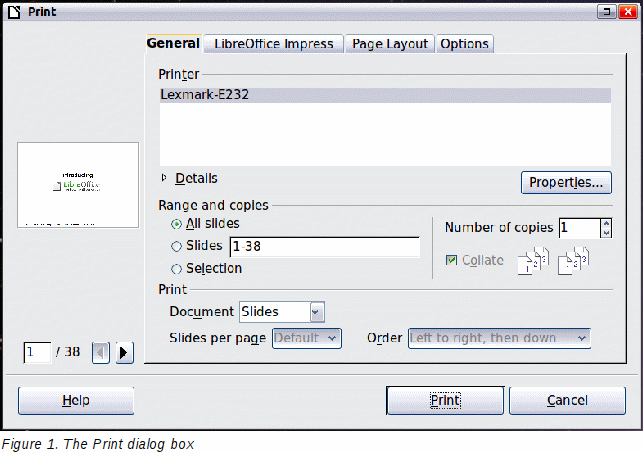
The Print dialog box has four tabs, from which you can choose a range of options, as described in the following sections.
|
Note |
The options selected on the Print dialog box apply to this printing of this document only. To specify default printing settings, go to Tools > Options > LibreOffice – Print and Tools > Options > LibreOffice Impress – Print. See “Selecting default print options” on page 8 for more information. |
Selecting general printing options
On the General tab of the Print dialog box (Figure 1), you can choose:
The printer (from the printers available)
Which slides to print, the number of copies to print, and whether to collate multiple copies (Range and copies section)
Whether to print slides, notes, handouts, or an outline of the presentation.
For handouts, how many slides per printed page and in what order (see page 7 for details).
Click the Properties button to display a dialog box where you can choose portrait or landscape orientation, which paper tray to use, and the paper size to print on.
The Options tab of the Print dialog provides other choices, as shown in Figure 2.
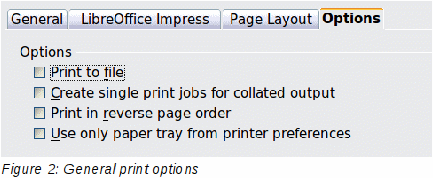
Printing multiple pages on a single sheet of paper
You can print multiple pages of a document on one sheet of paper. To do this:
In the Print dialog, select the Page Layout tab (Figure 3).
In the Layout section, select from the drop-down list the number of pages to print per sheet. The preview panel on the left of the Print dialog shows how the printed document will look.
When printing more than 2 pages per sheet, you can choose the order in which they are printing across and down the paper. The two pictures in Figure 3 show the difference.
In the Page sides section, select whether to print all pages or only some pages.
Click the Print button.
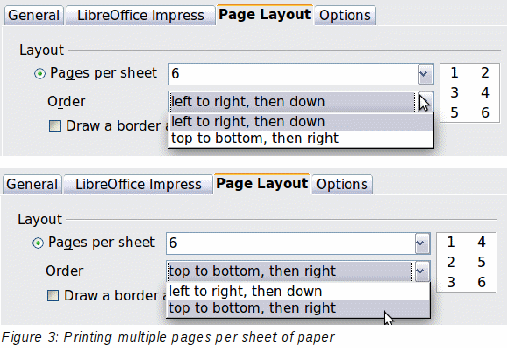
In addition to printing a full presentation, you can choose to print individual slides, ranges of slides, or a selection of slides, using the Ranges and copies section of the General page of the Print dialog box.
Be sure Slides is selected in the Document box in the Print section.
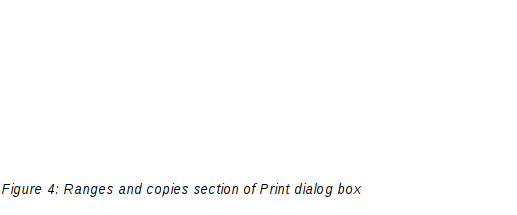
To print an individual slide or several slides, do either of the following:
Open the Print dialog box, choose the Slides option in the Ranges and copies section, type the slide number, and click Print. Multiple slides may be represented by a list (for example 1,3,7,11) or a range (for example 1-4).
Select the slide in the Slides pane or the Slide Sorter view, then open the Print dialog box and choose Selection in the Ranges and copies section, and click Print.
Selecting other information to print
On the LibreOffice Impress tab of the Print dialog box, you can choose:
What to print in addition to the slides: Slide name, date and time, and hidden slides (pages).
Whether to print in color, grayscale, or black and white (on a color printer).
What size to print slides.
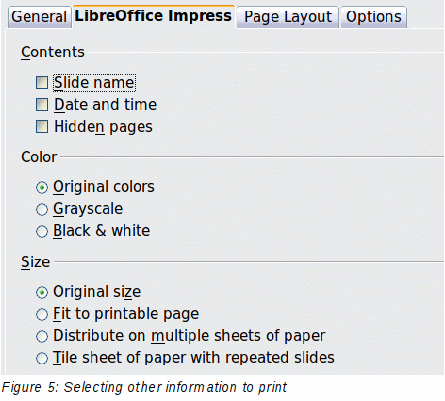
Printing in black and white (on a color printer)
You may wish to print slides in black and white or grayscale on a color printer. To do this, choose either Grayscale or Black & white in the Color section on the LibreOffice Impress tab of the Print dialog box (Figure 5).
Printing handouts, notes, or outlines in Impress
The Document box also gives you the option of printing Handouts, Notes, or an Outline.
Handouts prints the slides in reduced size on the page, from one to nine slides per page. The slides can be printed horizontally (landscape orientation) or vertically (portrait orientation) on the page.
Notes prints a single slide per page with any notes entered for that slide in Notes View.
Outline prints the title and headings of each slide in outline format.
To print handouts, notes, or outlines:
Choose File > Print from the menu bar.
In the Print section of the Print dialog box, select the required option from the Document box.
For Handouts, you can then choose how many slides to print per page, and the order in which they are printed.
Click the Print button.
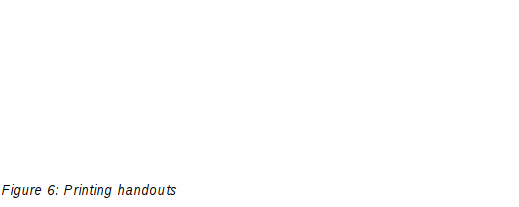
Selecting default print options
Selections on the Print dialog box over-ride any default settings. To specify default settings for printing, use Tools > Options > LibreOffice Impress > Print.
Other printer settings are found in Tools > Options > LibreOffice > Print, as shown in Figure 5. Use this page to specify quality settings for printing, and whether to have Impress warn you if the paper size or orientation of your document does not match the printer settings.
See Chapter 11, Setting Up and Customizing Impress, for details.
You can print a presentation with two slides on each side of a sheet of paper, arranged so that when the printed pages are folded in half, the slides are in the correct order to form a booklet or brochure.
To print a brochure on a single-sided printer:
Choose File > Print.
In the Print dialog, click Properties.
Check the printer is set to the same orientation (portrait or landscape) as specified in the page setup for your document. Usually the orientation does not matter, but it does for brochures. Click OK to return to the Print dialog.
Select the Page layout tab in the Print dialog (Figure 7).
Select the Brochure option.
In the Page sides section, select Back sides / left pages option from the Include drop-down list.
|
Tip |
If your printer can print double-sided automatically, choose All pages. |
Click the Print button.
Take the printed pages out of the printer, turn the pages over, and put them back into the printer in the correct orientation to print on the blank side. You may need to experiment a bit to find out what the correct arrangement is for your printer.
On the Print dialog, in the Page sides section, select Front sides / right pages option from the Include drop down box. Click the Print button.
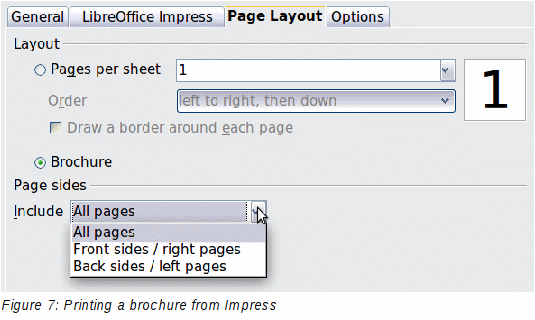
Impress can export presentations to PDF (Portable Document Format). This industry-standard file format for file viewing is ideal for sending the file to someone else to view using Adobe Reader or other PDF viewers.
Click
the Export
Directly as PDF icon
![]() to export the entire presentation using the default PDF settings. You
are asked to enter the file name and location for the PDF file, but
you do not get a chance to choose a page range or the print quality.
to export the entire presentation using the default PDF settings. You
are asked to enter the file name and location for the PDF file, but
you do not get a chance to choose a page range or the print quality.
Controlling PDF content and quality
For more control over the content and quality of the resulting PDF, use File > Export as PDF. The PDF Options dialog box opens. This dialog box has five pages, described in this section. Make your selections, and then click Export. Then you are asked to enter the location and file name of the PDF to be created, and click Save to export the file.
General page of PDF Options dialog box
On the General page, you can choose which pages (slides) to include in the PDF, the type of compression to use for images (which affects the quality of images in the PDF), and other options.
Range section
All: Exports the entire document.
Pages: To export a range of slides, use the format 3-6 (pages 3 to 6). To export single slides, use the format 7;9;11 (slides 7, 9, and 11). You can also export a combination of slide ranges and single slides, by using a format like 3 6;8;10;12.
Selection: Exports whatever material is selected.
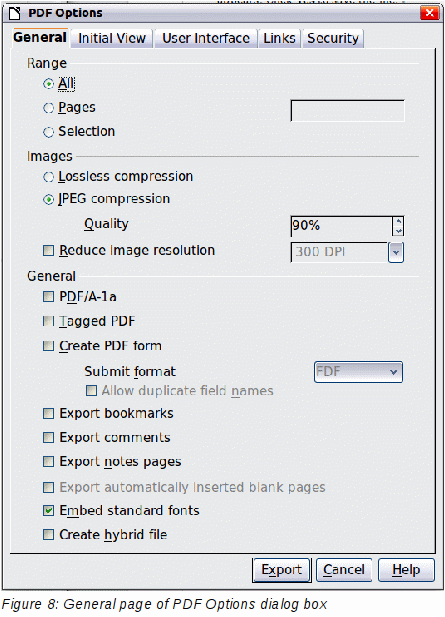
Images section
Lossless compression: Images are stored without any loss of quality. Tends to make large files when used with photographs. Recommended for other kinds of images or graphics.
JPEG compression: Allows for varying degrees of quality. A setting of 90% tends to work well with photographs (small file size, little perceptible loss).
Reduce image resolution: Lower-DPI (dots per inch) images have lower quality. For viewing on a computer screen generally a resolution of 72dpi (for Windows) or 96dpi (GNU/Linux) is sufficient, while for printing it is generally preferable to use at least 300 or 600 dpi, depending on the capability of the printer. Higher dpi settings greatly increase the size of the exported file.
|
Note |
EPS (Encapsulated PostScript) images with embedded previews are exported only as previews. EPS images without embedded previews are exported as empty placeholders. |
General section
PDF/A-1: PDF/A is an ISO standard for long-term preservation of documents, by embedding all the information necessary for faithful reproduction (such as fonts) while forbidding other elements (including forms, security, and encryption). PDF tags are written. If you select PDF/A-1, the forbidden elements are grayed-out (not available).
Tagged PDF: Tagged PDF contains information about the structure of the document’s contents. This can help to display the document on devices with different screens, and when using screen reader software. Some tags that are exported are table of contents, hyperlinks, and controls. This option can increase file sizes significantly.
Create PDF form - Submit format: Choose the format of submitting forms from within the PDF file. This setting overrides the control’s URL property that you set in the document. There is only one common setting valid for the whole PDF document: PDF (sends the whole document), FDF (sends the control contents), HTML, and XML. Most often you will choose the PDF format.
Export bookmarks: Exports slide names as “bookmarks” (a table of contents list displayed by some PDF readers, including Adobe Reader).
Export comments: Exports comments as PDF notes. You may not want this!
Export notes pages: Exports a set of Notes pages after the set of slides.
Export automatically inserted blank pages: Not used in Impress.
Embed standard fonts: Normally the 14 standard PostScript fonts are not embedded in a PDF file, because PDF reader software already contains these fonts. However, you can choose to embed these fonts in all PDF documents created by LibreOffice to enhance display accuracy in PDF viewers. Font embedding may also be required by some printers.
Create hybrid file: When the PDF Import Extension is installed, this option exports the document as a .PDF file containing two file formats: PDF and ODP.
Initial View page of PDF Options dialog box
Figure 9: Initial View page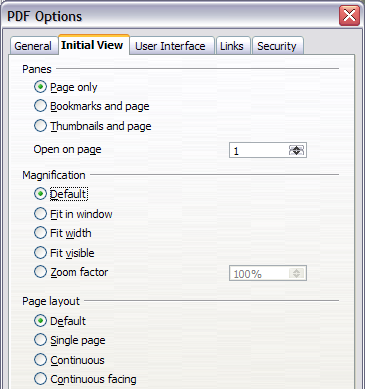
On the Initial View page, you can
choose how the PDF opens by default in a PDF viewer. The selections
should be self-explanatory.
If you have Complex Text Layout enabled (in Tools > Options > Language settings > Languages), an additional selection is available under Continuous facing: First page is left (normally, the first page is on the right when using the Continuous facing option).
User Interface page of PDF Options dialog box
On the User Interface page, you can choose more settings to control how a PDF viewer displays the file. Some of these choices are particularly useful when you are creating a PDF to be used as a presentation or a kiosk-type display.
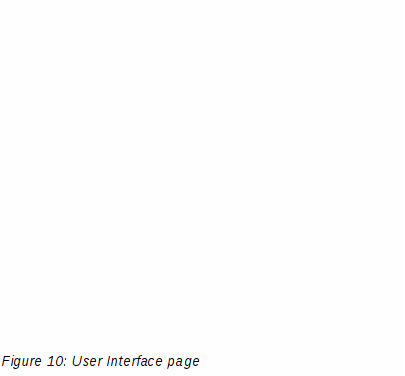
Window options section
Resize window to initial page. Causes the PDF viewer window to resize to fit the first page of the PDF.
Center window on screen. Causes the PDF viewer window to be centered on the computer screen.
Open in full screen mode. Causes the PDF viewer to open full-screen instead of in a smaller window.
Display document title. Causes the PDF viewer to display the document’s title in the title bar.
User interface options section
Hide menubar. Causes the PDF viewer to hide the menu bar.
Hide toolbar. Causes the PDF viewer to hide the toolbar.
Hide window controls. Causes the PDF viewer to hide other window controls.
Transitions section
Includes Impress slide transition effects as the respective PDF effects.
Bookmarks section
Select how many heading levels are displayed as bookmarks, if Export bookmarks is selected on the General page.
Links page of PDF Options dialog box
On the Links page, you can choose how links are exported to PDF.
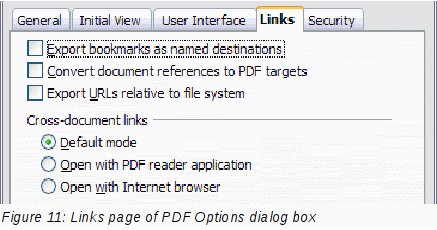
Export bookmarks as named destinations
If you have defined Writer bookmarks, Impress or Draw slide names, or Calc sheet names, this option exports them as “named destinations” to which Web pages and PDF documents can link.
Convert document references to PDF targets
If you have defined links to other documents with OpenDocument extensions (such as .ODT, .ODS, and .ODP), this option converts the files names to .PDF in the exported PDF document.
Export URLs relative to file system
If you have defined relative links in a document, this option exports those links to the PDF.
Cross-document links
Defines the behavior of links clicked in PDF files.
Security page of PDF Options dialog box
PDF export includes options to encrypt the PDF (so it cannot be opened without a password) and apply some digital rights management (DRM) features.
|
Note |
Permission settings are effective only if the user’s PDF viewer respects the settings. |
With an open password set, the PDF can only be opened with the password. Once opened, there are no restrictions on what the user can do with the document (for example, print, copy, or change it).
With a permission password set, the PDF can be opened by anyone, but its permissions can be restricted. See the options on Figure 12.
With both the open password and permission password set, the PDF can only be opened with the correct password, and its permissions can be restricted.
Figure 13 shows the pop-up dialog box displayed when you click the Set passwords button on the Security page of the PDF Options dialog box.
After you set a permission password, the other choices on the Security page (shown in Figure 12) become available. These selections should be self-explanatory.
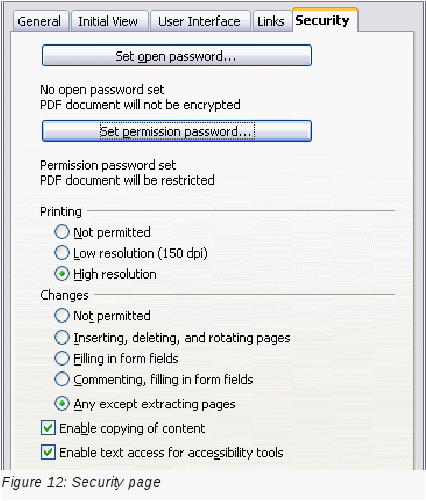
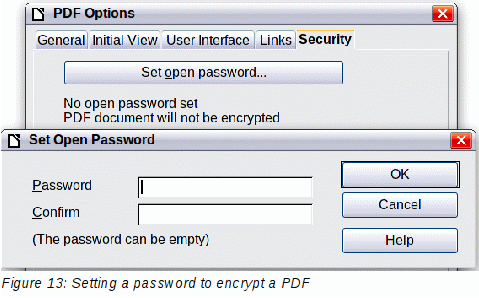
Macromedia Flash file format (.SWF) was created to store animation for web pages. Because almost all browsers play Flash movies (the Adobe Flash Player is available as a free download for those without Flash-capable browsers), these files can be viewed by just about anyone. With LibreOffice, you can export your Impress slide show as a .SWF file. To download the latest Adobe Flash Player for your operating system, go to: http://www.adobe.com/products/flashplayer/
|
Note |
Saving in Flash format does not retain animation and slide transitions. |
To export the presentation as a Flash (.SWF) file:
Choose File > Export.
Select the location where you want the file saved and type a name for the file.
Under File Format, choose Macromedia Flash (SWF) (.swf) and click Save.
Exporting as web pages (HTML files)
You can export presentations as a series of web pages that can be viewed in any browser.
|
Note |
Saving as web pages (HTML format) does not retain animation and slide transitions. |
Select File > Export and choose HTML Document as the file type.
Create a folder for the files, supply a name for the resulting HTML file, and click Save. The HTML Export Wizard opens.
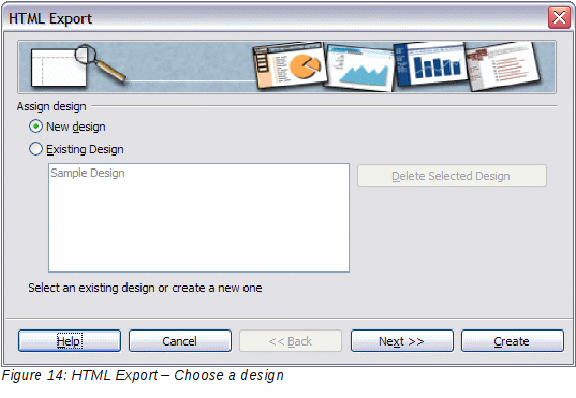
Choose a design for all of the pages, either from an existing design or by creating a new one. If you have not previously saved a design, the Existing Design choice is not available.
Click Next to select the type of web pages to create.
Standard HTML: one page for each slide, with navigation links to move from slide to slide.
Standard HTML with frames: one page with a navigation bar on the left-hand side; uses slide title as navigation links. Click on links to display pages in right-hand side.
Automatic: one page for each slide, with each page set with the Refresh meta tag so a browser automatically cycles from one page to the next.
WebCast: generates an ASP or Perl application to display the slides. Unfortunately LibreOffice has no direct support for PHP yet.
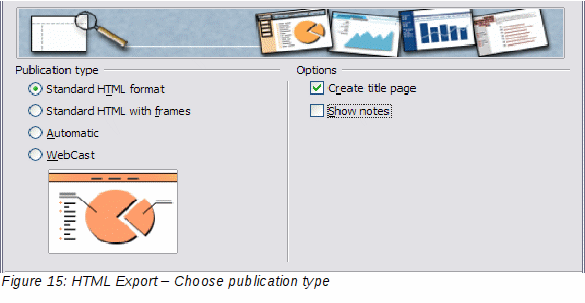
Decide how the images will be saved (PNG, GIF or JPG) and what resolution to use. When choosing a resolution, consider what the majority of your viewers might have. If you use a high resolution, then a viewer with a medium-resolution monitor will have to scroll sideways to see the entire slide—probably not desirable.
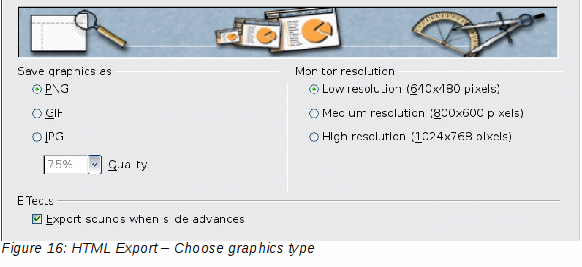
If Create title page was chosen in step 4, supply the information for it on the next page. The title contains an author name, e-mail address and home page, along with any additional information you want to include.
This page of the Wizard does not display if Create title page was not chosen.
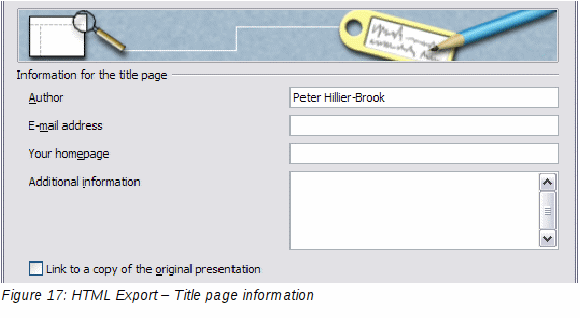
Choose the navigation button style to use to move from one page to another. If you do not choose any, LibreOffice will create a text navigator.
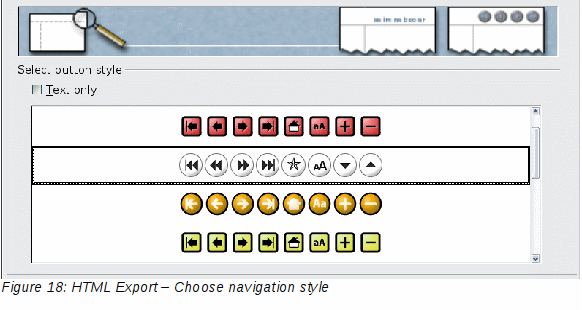
Select the color scheme for the web pages. Available schemes include the document’s existing scheme, one based upon browser colors, and a completely user-defined scheme. You can save a new scheme so that it will appear on the first page of the HTML export wizard.
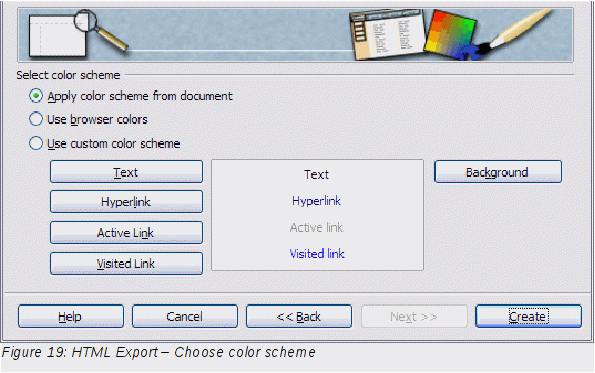
Click Create to generate the HTML files. If this is a new design, a small dialog box pops up. If you might want to reuse this design, you can give it a name and save it. Otherwise, click Do Not Save.
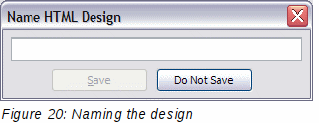
LibreOffice provides several ways to quickly and easily send a Writer document as an e-mail attachment in one of three formats: .ODP (OpenDocument Presentation, LibreOffice’s default format), .PPT (Microsoft PowerPoint format), or PDF.
To send the current document in .ODP format:
Choose File > Send > Document as E-mail. LibreOffice opens a new e-mail in your default e-mail program. The document is attached.
In your e-mail program, enter the recipient, subject and any text you want to add, then send the e-mail.
File > Send > E-mail as OpenDocument Presentation has the same effect.
If you choose E-mail as Microsoft PowerPoint Presentation, LibreOffice first creates a .PPT file and then opens your e-mail program with the .PPT file attached. The .PPT file is not saved on your computer.
Similarly, if you choose E-mail as PDF, LibreOffice first creates a PDF using your default PDF settings (as when using the Export Directly as PDF toolbar button) and then opens your e-mail program with the .PDF file attached. The PDF file is not saved on your computer.
|
Tip |
If you want to keep a copy of the .PPT or .PDF file as well as e-mailing it to someone, first save or export the presentation into the required format, then attach it to an e-mail in the usual way. |
To sign a document digitally, you need a personal key, also known as a certificate. A personal key is stored on your computer as a combination of a private key, which must be kept secret, and a public key, which you add to your documents when you sign them. You can get a certificate from a certification authority, which may be a private company or a governmental institution.
When you apply a digital signature to a document, a kind of checksum is computed from the document’s content plus your personal key. The checksum and your public key are stored together with the document.
When someone later opens the document on any computer with a recent version of LibreOffice, the program will compute the checksum again and compare it with the stored checksum. If both are the same, the program will signal that you see the original, unchanged document. In addition, the program can show you the public key information from the certificate. You can compare the public key with the public key that is published on the web site of the certificate authority.
Whenever someone changes something in the document, this change breaks the digital signature.
On Windows operating systems, the Windows features of validating a signature are used. On Solaris and Linux systems, files that are supplied by Thunderbird, Mozilla or Firefox are used. For a more detailed description of how to get and manage a certificate, and signature validation, see “Using Digital Signatures” in the LibreOffice Help.
To sign a document:
Choose File > Digital Signatures.
If you have not saved the document since the last change, a message appears. Click Yes to save the file.
After saving, you see the Digital Signatures dialog box. Click Add to add a public key to the document.
In the Select Certificate dialog box, select your certificate and click OK.
You see again the Digital Signatures dialog box, where you can add more certificates if you want. Click OK to add the public key to the saved file.
A
signed document shows an icon
![]() in the status bar. You can double-click the icon to view the
certificate.
in the status bar. You can double-click the icon to view the
certificate.
You may wish to ensure that personal data, versions, notes, hidden information, or recorded changes are removed from files before you send them to other people or create PDFs from them.
In Tools > Options > LibreOffice > Security > Options, you can set LibreOffice to remind (warn) you when files contain certain information and remove personal information automatically when saving the file or when creating a PDF.
To remove personal and some other data from a file, go to File > Properties. On the General tab, uncheck Apply user data and then click the Reset button. This removes any names in the created and modified fields, deletes the modification and printing dates, and resets the editing time to zero, the creation date to the current date and time, and the version number to 1. Be sure to click OK to save the changes.
Opening and saving a PowerPoint file
LibreOffice’s Impress file format is highly compatible with Microsoft’s PowerPoint format. You can open a PowerPoint presentation in Impress, edit it, then save it in its original PowerPoint format or in Impress’s OpenDocument Presentation format. You can also create a new presentation in Impress and save it as a PowerPoint file.
|
Caution
|
There are some differences between OpenDocument (.odp) and PowerPoint (.ppt, .pptx) files in text and graphics formatting, animations, transitions, and fields. For best results, avoid using features that are not fully supported in both formats. |
Saving an Impress file as a PowerPoint file
Choose File > Save As from the menu bar.
Select the location where you want the PowerPoint file saved and type a name for the file.
Under File type, choose Microsoft PowerPoint 97/2000/XP (.ppt) or Microsoft Powerpoint 2007 XML (.pptx).
Click Save. If you have the “Warn when not saving in ODF or default format” option set in Options > Load/Save > General, the message shown in Figure 21 appears. Click Keep Current Format to confirm that you want to save the file in Microsoft PowerPoint format. You can deselect the Ask when not saving in ODF format checkbox to not show the message again unless you re-enable it in the Options.
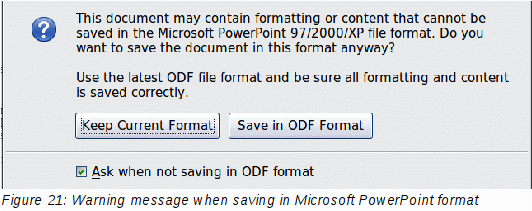
|
Tip |
Always save your work in Impress OpenDocument format (.odp) before saving in Microsoft format. Keep the Impress file as your working copy: if you need to change the presentation, change it in the Impress version and then save it again as PowerPoint. You are much less likely to have problems than if you open a file previously saved in PowerPoint format, edit it, and save it again. |
Opening a PowerPoint file in Impress
If you receive a file from someone in PowerPoint format and need to edit it in Impress, here is how:
In LibreOffice, choose File > Open from the menu bar.
Under File type, choose All files (*.*) or Presentations or Microsoft PowerPoint 97/2000/XP from the drop-down list.
Navigate to the PowerPoint file, select it, and click Open.
The PowerPoint file can now be edited and saved as an Impress file or a PowerPoint file. To save the file as an Impress file, choose OpenDocument Presentation (.odp) as the File Type.